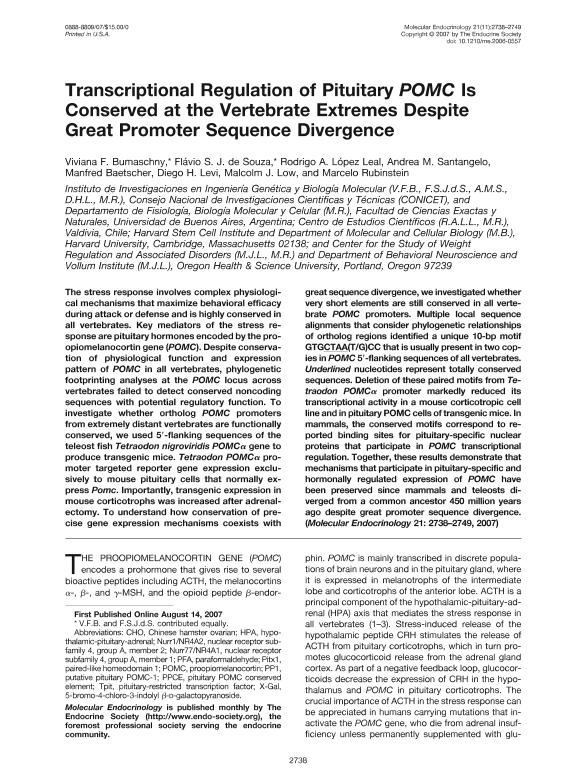Mostrar el registro sencillo del ítem
dc.contributor.author
Bumaschny, Viviana Florencia

dc.contributor.author
Silva Junqueira de Souza, Flavio

dc.contributor.author
López Leal, Rodrigo A.
dc.contributor.author
Santangelo, Andrea Mariana

dc.contributor.author
Baetscher, Manfred
dc.contributor.author
Levi, Diego H.
dc.contributor.author
Low, Malcolm J.

dc.contributor.author
Rubinstein, Marcelo

dc.date.available
2019-07-18T18:41:43Z
dc.date.issued
2007-11
dc.identifier.citation
Bumaschny, Viviana Florencia; Silva Junqueira de Souza, Flavio; López Leal, Rodrigo A.; Santangelo, Andrea Mariana; Baetscher, Manfred; et al.; Transcriptional regulation of pituitary POMC is conserved at the vertebrate extremes despite great promoter sequence divergence; Endocrine Society; Molecular Endocrinology; 21; 11; 11-2007; 2738-2749
dc.identifier.issn
0888-8809
dc.identifier.uri
http://hdl.handle.net/11336/79815
dc.description.abstract
The stress response involves complex physiological mechanisms that maximize behavioral efficacy during attack or defense and is highly conserved in all vertebrates. Key mediators of the stress response are pituitary hormones encoded by the proopiomelanocortin gene (POMC). Despite conservation of physiological function and expression pattern of POMC in all vertebrates, phylogenetic footprinting analyses at the POMC locus across vertebrates failed to detect conserved noncoding sequences with potential regulatory function. To investigate whether ortholog POMC promoters from extremely distant vertebrates are functionally conserved, we used 5′-flanking sequences of the teleost fish Tetraodon nigroviridis POMCα gene to produce transgenic mice. Tetraodon POMCα promoter targeted reporter gene expression exclusively to mouse pituitary cells that normally express Pomc. Importantly, transgenic expression in mouse corticotrophs was increased after adrenalectomy. To understand how conservation of precise gene expression mechanisms coexists with great sequence divergence, we investigated whether very short elements are still conserved in all vertebrate POMC promoters. Multiple local sequence alignments that consider phylogenetic relationships of ortholog regions identified a unique 10-bp motif GTGCTAA(T/G)CC that is usually present in two copies in POMC 5′-flanking sequences of all vertebrates. Underlined nucleotides represent totally conserved sequences. Deletion of these paired motifs from Tetraodon POMCα promoter markedly reduced its transcriptional activity in a mouse corticotropic cell line and in pituitary POMC cells of transgenic mice. In mammals, the conserved motifs correspond to reported binding sites for pituitary-specific nuclear proteins that participate in POMC transcriptional regulation. Together, these results demonstrate that mechanisms that participate in pituitary-specific and hormonally regulated expression of POMC have been preserved since mammals and teleosts diverged from a common ancestor 450 million years ago despite great promoter sequence divergence.
dc.format
application/pdf
dc.language.iso
eng
dc.publisher
Endocrine Society

dc.rights
info:eu-repo/semantics/openAccess
dc.rights.uri
https://creativecommons.org/licenses/by-nc-sa/2.5/ar/
dc.subject
Pomc
dc.subject
Tetraodon
dc.subject
Evolution
dc.subject
Pituitary
dc.subject.classification
Bioquímica y Biología Molecular

dc.subject.classification
Ciencias Biológicas

dc.subject.classification
CIENCIAS NATURALES Y EXACTAS

dc.title
Transcriptional regulation of pituitary POMC is conserved at the vertebrate extremes despite great promoter sequence divergence
dc.type
info:eu-repo/semantics/article
dc.type
info:ar-repo/semantics/artículo
dc.type
info:eu-repo/semantics/publishedVersion
dc.date.updated
2019-07-15T13:55:54Z
dc.journal.volume
21
dc.journal.number
11
dc.journal.pagination
2738-2749
dc.journal.pais
Estados Unidos

dc.journal.ciudad
Baltimore
dc.description.fil
Fil: Bumaschny, Viviana Florencia. Consejo Nacional de Investigaciones Científicas y Técnicas. Instituto de Investigaciones en Ingeniería Genética y Biología Molecular "Dr. Héctor N. Torres"; Argentina
dc.description.fil
Fil: Silva Junqueira de Souza, Flavio. Consejo Nacional de Investigaciones Científicas y Técnicas. Instituto de Investigaciones en Ingeniería Genética y Biología Molecular "Dr. Héctor N. Torres"; Argentina
dc.description.fil
Fil: López Leal, Rodrigo A.. Centro de Estudios Cientificos; Chile
dc.description.fil
Fil: Santangelo, Andrea Mariana. Consejo Nacional de Investigaciones Científicas y Técnicas. Instituto de Investigaciones en Ingeniería Genética y Biología Molecular "Dr. Héctor N. Torres"; Argentina
dc.description.fil
Fil: Baetscher, Manfred. Harvard University; Estados Unidos
dc.description.fil
Fil: Levi, Diego H.. Consejo Nacional de Investigaciones Científicas y Técnicas. Instituto de Investigaciones en Ingeniería Genética y Biología Molecular "Dr. Héctor N. Torres"; Argentina
dc.description.fil
Fil: Low, Malcolm J.. Oregon Health and Science University; Estados Unidos
dc.description.fil
Fil: Rubinstein, Marcelo. Consejo Nacional de Investigaciones Científicas y Técnicas. Instituto de Investigaciones en Ingeniería Genética y Biología Molecular "Dr. Héctor N. Torres"; Argentina. Universidad de Buenos Aires. Facultad de Ciencias Exactas y Naturales. Departamento de Fisiología, Biología Molecular y Celular; Argentina. Centro de Estudios Cientificos; Chile. Oregon Health and Science University; Estados Unidos
dc.journal.title
Molecular Endocrinology

dc.relation.alternativeid
info:eu-repo/semantics/altIdentifier/url/https://www.ncbi.nlm.nih.gov/pubmed/17698954
dc.relation.alternativeid
info:eu-repo/semantics/altIdentifier/doi/http://dx.doi.org/10.1210/me.2006-0557
dc.relation.alternativeid
info:eu-repo/semantics/altIdentifier/url/https://academic.oup.com/mend/article/21/11/2738/2738430
Archivos asociados
